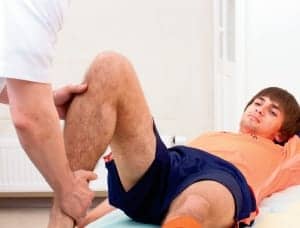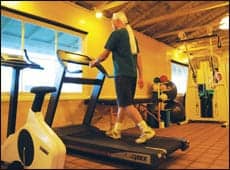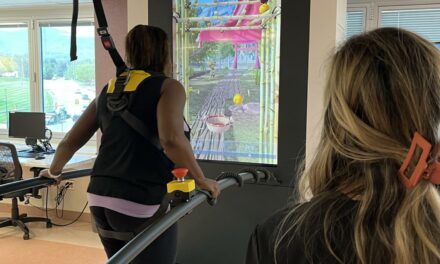
FThe first medical professional some young athletes may see about an injury—particularly in direct access states—is a physical therapist. In such cases, therapists must be prepared to take a considerable role in making a diagnosis.
Successfully treating youth sports injuries and enabling a young athlete to return to the field or court can be one of the most rewarding experiences for a sports medicine surgeon. There are special challenges, too, however, in addressing the types of injuries and behaviors associated with this patient population. Physical therapists who work closely and consistently with patients may observe important details about recovery that are critical in the final return to play decision.
Youth sports injuries related to overuse have reached the highest level ever. Some of the reasons for this increase can be attributed to the often combined attempts of parents, coaches, and athletes themselves to build the athlete’s expertise in a single sport, rather than developing skills among several different sports. For example, a singular focus on baseball may result in a young athlete developing arm and shoulder problems. Likewise, concentrating only on basketball or soccer will elevate an athlete’s risk of knee injury. To treat and help prevent overuse problems among youth athletes, health care providers can best help their patients by acting as a team.
FEAR OF THE DOCTOR VISIT
Sports medicine surgeons frequently see young athletes who have been playing through pain for months. By the time an athlete seeks medical attention for an injury, they may already have been unable to play for weeks or months. The fear harbored by young athletes about being shut down for a game, a few weeks, or a season is quite real. Even worse is that some young athletes or parents may not even seek medical opinion out of fear an injury may require surgery. As a result, the first medical professional some young athletes may see about an injury is a physical therapist. This is more likely to occur in states where direct access to a physical therapist without physician referral is allowed. In such cases, physical therapists must be prepared to take a considerable role in making a diagnosis.
Overuse injuries can afflict bones, muscles, tendons, and ligaments. Establishing a consistent protocol for determining which injuries warrant urgent referral to an orthopedic surgeon is a difficult task, but one for which therapists should be prepared. Following are general principles to apply when evaluating an injured young athlete for referral to an orthopedic surgeon:
- Inability to use the arm or leg. Either condition most often warrants urgent referral to an orthopedic surgeon.
- Quality of pain. Distinctions between sharp and dull pain do not necessarily suggest one injury is significant while another is not. Location of pain, such as localized pain on a specific part of a bone or joint, could be more significant. The fact that pain does not improve with rest or after several sessions of physical therapy, modalities, and other common treatment also might be important.
- Mechanical symptoms. Symptoms such as locking, catching, giving way of the knee, clicking, feelings of subluxation, or dislocation in the shoulder often signify structural problems.
- Inability to perform as desired. If an athlete cannot do what they want to in the sport, it is reasonable to make a referral to a sports medicine surgeon. For example, a young pitcher may have shoulder pain that does not preclude him from throwing, but causes velocity to decrease, or affects the ability to locate pitches. A female runner may not have knee pain running on flat surfaces, but has tremendous anterior knee pain while running down hills.
Essentially, if an athlete cannot perform the sport or exercise as well as they would like because of an injury, it is reasonable to refer that athlete to a sports medicine surgeon for review.
ROLE OF THE PHYSICAL THERAPIST IN REHABILITATION

If an athlete cannot do what they want in a sport, it is reasonable to make a referral to a sports medicine surgeon.
Most often, athletes work with a physical therapist after seeing an orthopedic surgeon, undergoing physical examination and x-rays, and receiving a diagnosis. Typically, orthopedic surgeons do not presume to know techniques, modalities, and exercises to rehabilitate each injury as well as a physical therapist. A physician would be more likely to offer a diagnosis of the injury in conjunction with guidelines for the therapist. At most, an orthopedic physician might emphasize certain motions, muscle movements, or activities that could adversely affect recovery. Most orthopedic surgeons will agree the development of specific rehabilitation plans should be deferred to physical therapy experts.
Having said that, there are several areas where physical therapists can be very helpful in diagnosing and treating injuries, and taking steps to prevent them. Developing collegial relationships between sports medicine surgeons and physical therapists or physical therapy teams can facilitate a flow of information that benefits both the providers and the athlete.
DEVELOPING TRUST WITH ONE-ON-ONE TIME
A young patient may spend a maximum of 15 minutes to 20 minutes with a physician in the evaluation process. In contrast, that same patient will likely spend 30 minutes to 60 minutes per session, two times or three times weekly, in physical therapy. During physical therapy sessions, the athlete and therapist develop a trusting relationship. The therapist may use that relationship to gather important information about the patient that may help an orthopedic surgeon make decisions about the course of treatment. Following are important questions a therapist may ask to more clearly gauge recovery.
What barriers are slowing recoveries? Are there problems observed during physical therapy sessions that do not manifest at rest? For example, does the knee swell after running on the treadmill? Are there other detrimental factors involved? Is the athlete not getting adequate sleep? Is the athlete not getting proper nutrition? Does the athlete sincerely want to return to sport or are they experiencing burnout?
Some of the physical exam findings that occur after working with a therapist help the surgeon identify and treat underlying problems. For example, if the PT finds swelling or mechanical symptoms of the knee (such as catching or giving way), that knowledge may lead the surgeon to order an MRI. Likewise, if the therapist notices the patient’s shoulder seems more unstable after aggressive shoulder exercises, that observation shared with the surgeon may provide the basis for obtaining an MR arthrogram.
Psychological or emotional issues can slow recovery from sports injuries and delay return to sport. Excessive fatigue or lack of proper nutrition may explain poor or slow recovery of muscle strength after surgery or injury. A therapist may notice parents or coaches placing excessive pressure on athletes, which could lead to depression or ambivalence toward playing. When therapists convey information they have gathered—information unlikely to be revealed during a visit to a physician’s office—surgeons can use this to work together with parents and coaches to guide decisions about return to play.
Is the athlete really getting better? In the office, we can measure strength, range of motion, and joint stability at rest, and we can ask the patient if pain has resolved. The reporting of pain can be unreliable, however, particularly among young athletes whose desire to quickly return to play may cause them to underplay or underreport pain symptoms. By assessing sport-specific functions, however, a physical therapist may observe a patient’s true pain symptoms with clarity. During the assessment, an athlete may exhibit a slight limp with sprints, pushing off on one side, or landing awkwardly or with lack of balance. This information can help orthopedic surgeons better decide when an athlete is ready to return to play.
How does the examination change after exertion? During the office visit, a physician sees a young athlete at rest. The muscles are rested and often work to protect the injured joint. At rest, many injuries may not be particularly painful. Unlike most physicians, however, physical therapists can use a therapy session to fatigue muscle groups. By changing the state of injured tissues, a clinician can better answer questions about recovery, such as whether the patella tracks abnormally when the quads tire, or whether the shoulder feels unstable once the deltoids and other shoulder muscles fatigue. This process also can reveal whether stressing one body part reproduces pain in a specific location. All of these findings may be missed in a doctor’s office. A thorough exam by a therapist can help a physician decide whether further diagnostic studies such as MRIs are needed, or if surgery is ultimately indicated.
INJURY PREVENTION FOR YOUNG ATHLETES
Physical therapy can play a crucial role in efforts to prevent injuries from occurring, or decrease the probability a repeat injury will occur. Following are three strategies for therapists to consider in helping prevent injury:
- Incorporate injury prevention exercises into the functional phases of rehabilitation. For example, teach proper ways to land from jumps and change direction while performing the balance and awareness of body position, or proprioception training, after ACL surgery. Static and dynamic stretching can play a key role in preventing injury and enhancing recovery, maximizing muscle elasticity and joint mobility while proprioceptively preparing the athlete. Teach maintenance rotator cuff and scapulothoracic exercises and posterior capsular stretching to overhead for athletes to add to daily workouts. Strength exercises also can be applied to build up an athlete during recovery. Using single leg, square stance, and/or split stance, integrating upper extremity movements can help encourage reactions in the ankles, knees, and hips.
- Correct faulty mechanics. Observe the techniques used, such as the motion for the tennis serve, and correct flaws that could unnecessarily stress certain areas. Include coaches and athletic trainers to observe the sessions to work on the corrections even after the athlete has returned to sports. Balance also can play an important role in good mechanics, and is something the therapist should observe. Ensuring stability in balance can help prevent injury and enhance recovery. Balancing exercises may first be applied on the most stable floor surfaces before allowing the athlete to progress to standing on foam or unstable surfaces, such as a wobble board or balance machine.
- Educate athletes about exercises and activities that can be performed safely while recovering from an injury. If a swimmer has a shoulder injury, a stationary bike or elliptical trainer may still be used for cardiovascular fitness. A male cross-country runner may still be allowed to perform upper body weight lifting, using free weights or resistance machines. The therapist can guide activities and exercises that do not place detrimental stresses on injured or recovering parts of the body. Therapy bands also may be used by each of these athletes, as the bands mimic the range of motion in most sports while providing athletes with a functional training exercise.
Allowing athletes to perform some exercise, even if not at their desired activity, may prevent some of the frustration and feelings of desperation athletes often have when they have suffered injury. Performing safe cardiovascular exercise or resistance training with treadmills and elliptical trainers, as well as therapy bands or resistance trainers, can help maintain conditioning through the recovery period. Preserving or improving fitness levels will help ease an athlete’s return to sports once a surgeon has cleared the athlete for play.
Sports medicine surgeons want physical therapists to share as much relevant information as possible to help guide plans for return to play. Therapists should be communicative and provide surgeons with regular updates. Most importantly, therapists should be proactive in asking physicians questions. Working as a team, sports medicine surgeons and physical therapists can more quickly and safely return injured young athletes back to sports they enjoy, where they can benefit from the fun and exercise they need as growing children.
David Geier Jr, MD, is Director of Sports Medicine at the Medical University of South Carolina and a Professor of Orthopaedic Surgery. He is Chief Physician for the annual Family Circle Women’s Tennis Tournament and has worked with pro, college, and youth sports teams. His Web site, www.DrDavidGeier.com, has helpful information of interest to physical therapists as well as parents, coaches, and young athletes.





